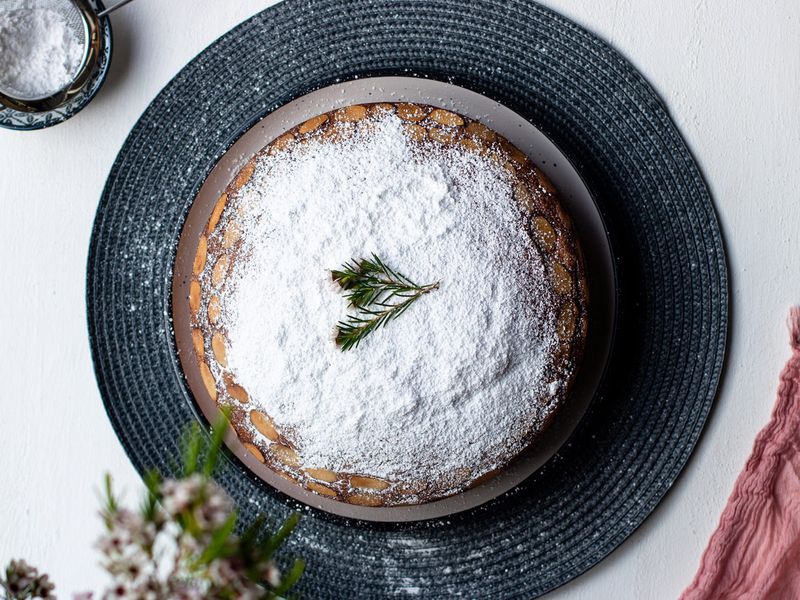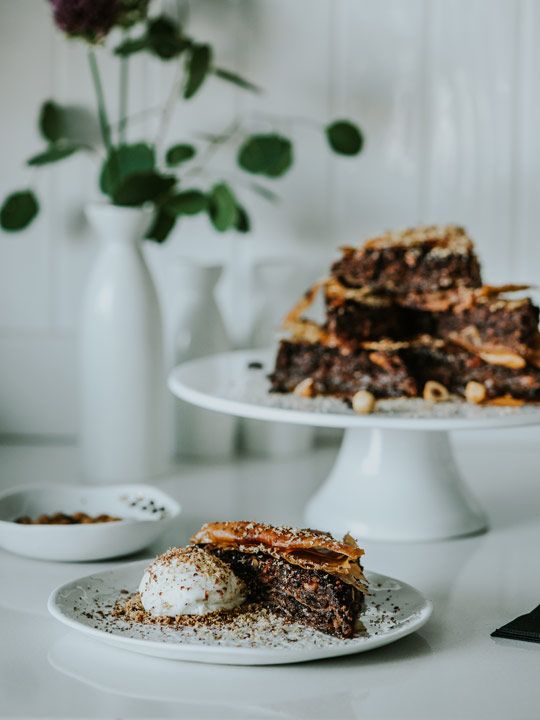Scottish Black Bun

Image Credit: Shutterstock
Just when we’d stuffed ourselves silly with fruitcakes over Christmas and sworn off them, the Scots have decided to test our resolve with the Black Bun – a fruitcake encased in pastry, eaten during Hogmanay (Scottish New Year’s Eve) celebrations. This recipe from Scottish restaurant Makar given to us by Chef Adam Tracey, Executive Chef at the Radisson Blu Hotel, Dubai Waterfront is a decadent melange of raisins, candied fruit peel and currants sealed in sticky treacle.
Scotch Bun, or Scottish Black Bun are the other monikers this fruitcake goes by and it was introduced to Scotland when Mary, Queen of Scots returned to Scotland from France.
A fun tradition this cake involves is hiding a bean in it and whoever finds it becomes king or queen for the evening. The chance of royal treatment sure does sound like reason enough to crack open the oven and belt out Auld Lang Syne.
Preparation time: 40 minutes
Baking time: 2 hours
Ingredients
For the filling
200gm all-purpose flour
200gm golden Raisins
400gm currants
1 tsp all Spice
1 tsp ground ginger
75gm soft brown sugar
25gm black treacle or dark molasses
100gm candied fruit peel, roughly chopped
½ tsp bicarbonate soda
1 egg
3 tbsp milk
For the pastry
200gm all-purpose flour
½ tsp baking powder
50gm butter, chilled
50gm vegetable shortening, chilled
Method
Step 1: Pastry
1. To make the pastry, put the flour, baking powder and a little salt in a cold mixing bowl. Add the butter and shortening and rub in until it starts to come together and look like breadcrumbs.
2. Make sure you handle the dough as little as possible. Stir in 4 tbsp of ice-cold water and mix to a soft dough. Cover with cling film and chill while you make the filling.
Step 2: Filling
Mix all the filling ingredients together in a large bowl.
Step 3: Baking
1. Preheat the oven to 180°C.
2. Meanwhile, dust your work surface with a little flour and roll out three-quarters of the dough to a rectangle large enough to line the base and sides of a loaf tin.
3. Drape the dough into the tin and smoothen out creases by pressing up the dough against the sides of the tin.
4. Pour the filling into the dough-covered tin. At this point, add a well-washed coin or a bean in the filing. Press down well.
5. Roll out the remaining pastry to a rectangle large enough to cover the top of the dough-covered loaf tin. Wet the edges of the pastry with water – this helps seal the pastry lid. Trim off any excess dough that falls over tin’s edges.
6. Bake for 2 hours before allowing to cool for at least an hour.
7. Remove the black bun from the tin, then cut into slices and serve.
Vasilopita (Greek New Year’s cake)

Image Credit: Courtesy Mythos Kouzina & Grill, Dubai
In Greece, Vasilopita is a traditional cake served at midnight on New Year’s Eve. Usually a flouri (coin) is hidden in it and the person served the piece with the flouri is the winner of the night.
This recipe by Chef Ilias Kokoroskos of Greek restaurant Mythos Kouzina & Grill, Dubai combines all the traditional ingredients and some chocolate chips for additional sweetness to start the New Year with.
Makes: 1 round baking tray of 28cm
Preparation time: 20 minutes
Baking time: 45 minutes
Ingredients
275gm butter
200gm icing sugar
Zest of ½ an orange
Pinch of nutmeg
4 tsp vanilla powder (if you can’t find vanilla powder, substitute it with 1 tsp of vanilla extract for every ½ teaspoon of powder.)
2 whole eggs (100gm)
85gm milk
1 tbsp fresh orange juice
400gm flour T65 (bread flour) or all-purpose flour
1 tsp baking powder
50gm walnuts, whole or chopped
100gm chocolate chips
Method
1. Whisk the butter, icing sugar, orange zest and nutmeg in a mixing bowl. Keep whisking until the mixture becomes fluffy.
2. In a separate bowl, crack the eggs and add the milk and orange juice. Whisk this mixture until the eggs and milk blend well and are well-incorporated.
3. Add the egg and milk mixture gently into the creamed butter and sugar gently. If you’re using an electric whisk, ensure you reduce the speed while pouring the second mixture into the bowl.
4. Fold in the flour, baking powder and walnuts into the mixture until well-incorporated. You know your cake batter is ready when you achieve a sticky mixture that has the consistency of cookie dough. Then add in the chocolate chip cookies and give it a good mix for about a minute, so the chocolate chips spread out evenly through the dough.
5. If you’re using an electric/stand whisk, change the whisk attachment for a paddle for step 4.
6. Pour the batter into a tray that has been lined with a baking sheet greased with butter. Then, insert a clean coin wrrapped in cling film or aluminium foil. Use a spatula to level and flatten the top of the cake batter and hide the coin.
7. Brush the top with egg wash (mixture of egg whites and water) for a shiny glaze. Then, place almond flakes in concentric circles, starting from the outer edge of the cake to the inside. This is optional and purely for decorative purposes.
8. Bake the cake in the oven at 170⁰C for 45 minutes. Insert a knife to check if it’s done – if the knife comes out clean, remove your cake from the oven.
9. Let the cake rest and cool to room temperature. Then dust with icing sugar.
Chocolate Hazelnut Baklava (with vanilla ice cream)

Image Credit: Courtesy of 21grams
Bringing a Middle Eastern twist to the Vasilopita above, various countries across the Balkan region eschew a cake and instead serve up either a dry or syrupy version of walnut baklava with a coin hidden inside. Then at midnight, or even breakfast on New Year’s Day, slices are distributed and whoever gets the coin is said to receive luck for the whole year.
Stasha Toncev, founder of Dubai-based Balkan restaurant 21grams, says if the coin is found by a guest, the host immediately offers to buy it from them so that the coin – and any luck with it – remains in the home. “It’s a very entertaining night full of excitement because of the adrenaline of finding the coin and the attempts to buy it back,” she said.
This recipe is a bold take on a Middle Eastern classic that is widely made and loved across the Balkan peninsula. Head chef Urosh Mitrasinovic of 21grams makes this sticky, flaky, sweet pastry with chocolate and hazelnuts, and serves it with vanilla ice cream. You can get creative with this many-layered treat, cutting out different shapes and size before baking.
Start now, because this recipe calls for cooling overnight!
Prep time: 30mins
Baking time: 45 mins
Servings: 30pcs
Ingredients
1kg hazelnuts, roasted, skin removed and cooled
600gm dark chocolate (77 per cent cocoa)
100gm butter
30gm cinnamon powder
20gm cocoa powder
750gm filo pastry
1kg white sugar
1.1 litre water
Vanilla ice cream, to serve
Method
1. Put the hazelnuts in a food processor and blitz on maximum speed a few times to ensure they’re crushed (not grinded). Repeat the process with the chocolate and mix it with the crushed hazelnuts.
2. Ensure the butter is at room temperature, then mix it with cinnamon and cocoa powder, thus creating a mixture for the pastry brush.
3. Take a 53 x 32.5cm baking pan and brush it with butter. Start layering filo pastry sheets (2 sheets per layer), brush with cocoa butter, then spread the chocolate hazelnut mix over. Keep repeating this sequence about 10 to 11 times. Ensure that the last layer is not brushed with cocoa butter, only regular butter.
4. At this stage, thoroughly wash a coin and insert it into the baklava. Then cut the pastry into squares or triangles. Dimensions and shapes are entirely up to you. Bake at 140°C for 45 minutes.
5. While the baklava is baking, prepare the syrup by mixing the water and sugar and bringing it to a boil.
6. Once the baklava is out of the oven, pour the syrup all over it. Ensure a temperature difference, so that the pastry and syrup are of different temperatures (hot/cold) to avoid the pastry cracking and to ensure that syrup soaks in evenly.
7. Let it cool overnight, then serve with a scoop of vanilla ice cream.





